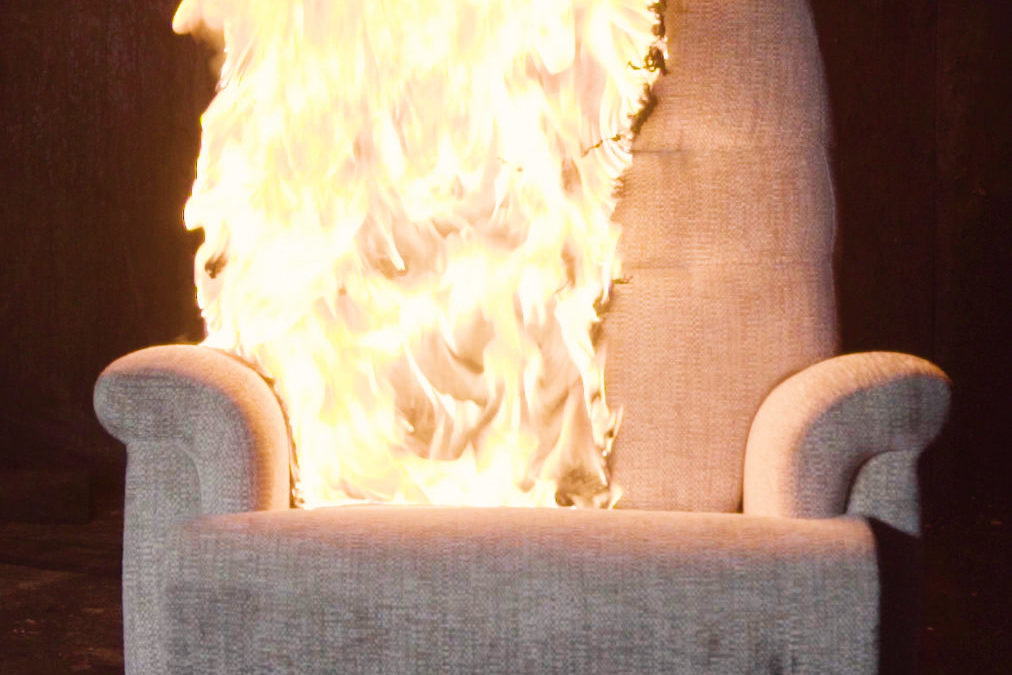The British Furniture Confederation (BFC) has produced a video which graphically demonstrates how consumers may be at risk from the sale of chairs, passed as safe, but likely to go up in flames.
The BFC, an alliance of the industry’s main trade associations, commissioned the video following new guidance from the Department for Business, Energy and Industrial Strategy (BEIS) and the Health & Safety Executive (HSE) regarding motorised furniture.
Said BFC chairman Jonathan Hindle:“The upshot of this guidance appears to be that two items of motorised furniture could be offered for sale in the UK side by side and Trading Standards would not be able to take any action against the supplier, even though the product did not conform to the current Furniture & Furnishings (Fire) (Safety) Regulations (FFFSR).”
The video shows one compliant and one non-compliant chair being subjected to a fire source equivalent to a burning match – with dramatically different results.
Said Jonathan: “The need for and effectiveness of the FFFSR is currently being questioned by a number of stakeholders but what prompted us to carry out this test was that we were informed that the Directive – which encompasses CE marking – covered all aspects of safety, including fire safety. It is therefore our understanding that a product that is CE marked in the EU, but outside the UK, can be CE marked as safe given it follows the guidelines within that country.”
The BFC was concerned at this advice, fearing that it could undermine the UK’s safety regime and put the public at risk. It therefore commissioned a piece of research looking at the fire safety performance of an electric rise and recline chair that conforms to the FFFSR, and of an identical chair constructed in materials used in furniture construction in the EU.
The video graphically demonstrates the speed of escalation of fire on the non-compliant chair compared with the compliant one, after a flame source equivalent to a match was applied for 20 seconds. The flames on the compliant chair self-extinguished within a few seconds of the source being removed. The non-compliant chair was burnt to a cinder within 10 minutes.
The BFC has submitted this video to Kelly Tolhurst, MP, Parliamentary Under Secretary of State, Minister for Small Business, Consumers and Corporate Responsibility at BEIS, to demonstrate that the suggestion that the Directive and the FFFSR offer the same level of fire safety is not the case and urgently needs revisiting.
“Our main concern is to protect the public by maintaining high levels of fire safety in the home. We believe that this film does demonstrate the ongoing effectiveness of the FFFSR in protecting the general public and that they need to be retained,” said Mr Hindle. “However, they are in urgent need of updating to reflect modern materials and manufacturing techniques and to ensure environmental concerns are met and we are urging government to engage in meaningful consultation as soon as possible.”
View the video and accompanying explanatory document here
Editor’s Notes:
1.UK furniture, bed and furnishings manufacturing is a substantial growth industry for the UK. Latest verified government figures from 2016 put total consumer expenditure on furniture and furnishings at £16.7 billion (a rise of 6% from 2015), supporting 327,000 jobs across 50,000 registered companies in the wider furniture and furnishings sector, including specialist retail but excluding general retail.
Manufacturing turnover for the sector rose 7.6% in 2016 for the eighth consecutive year, to £11.3 billion, emanating from 8,390 companies employing 118,000 individuals. Furniture manufacturing is one of the top three divisions driving manufacturing growth in the UK according to official statistics.
UK manufacturers have benefited from this rise in consumer demand, but it has also been fed by a rising tide of imports which reached £5.8 billion in 2016, a significant proportion of which arrived from China (£1.9 billion). However, export performance, albeit on a smaller scale, has also continued to improve, increasing by 13% from 2015 to 2016 to £1.13 billion.
Trade with the European Community continued to be the main source of export income and totalled £0.71 billion in 2016, an increase of 0.08 billion over the previous year, with France, Germany, The Netherlands, Belgium, Italy and Spain being the primary recipients. However, whilst exports to the EU are significant, the reality is that many of its countries are more reliant on the UK home market for their income, as illustrated by the £2.20 billion trade gap.1
2.The British Furniture Confederation is an executive body chaired by Jonathan Hindle and made up of representatives from the UK’s leading furniture, furnishings and bed trade associations:
British Contract Furnishing Association (BCFA)
British Furniture Manufacturers (BFM)
Furniture Industry Research Association (FIRA)
Leisure and Outdoor Furniture Association (LOFA)
National Bed Federation (NBF)
Worshipful Company of Furniture Makers (WCFM)
It also has affiliations with other trade associations including: the Association of Master Upholsterers and Soft Furnishers (AMUSF) and Anti-Copying In Design (ACID).
The British Furniture Confederation (BFC) maintains regular dialogue with Government and other influential stakeholders in an effort to ensure that its policies and initiatives support a thriving furniture, furnishings and bed sector. Many of its activities are done in partnership with the All Party Parliamentary Furniture Industry Group (APPFIG), chaired by Stephen McPartland MP.
Press enquiries: press@britishfurnitureconfederation.org.uk
Chairman: chairman@britishfurnitureconfederation.org.uk
Secretary & General enquiries: secretariat@britishfurnitureconfederation.org.uk
1 Statistics taken from FIRA’s Statistics Digest December 2017, a compilation of published statistics and market information which has been sourced primarily from the Office for National Statistics (ONS), HM Customs and Revenue, The Bank of England and the Communities.

